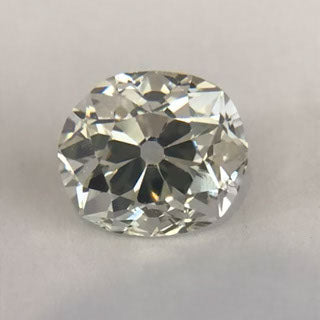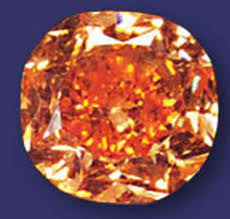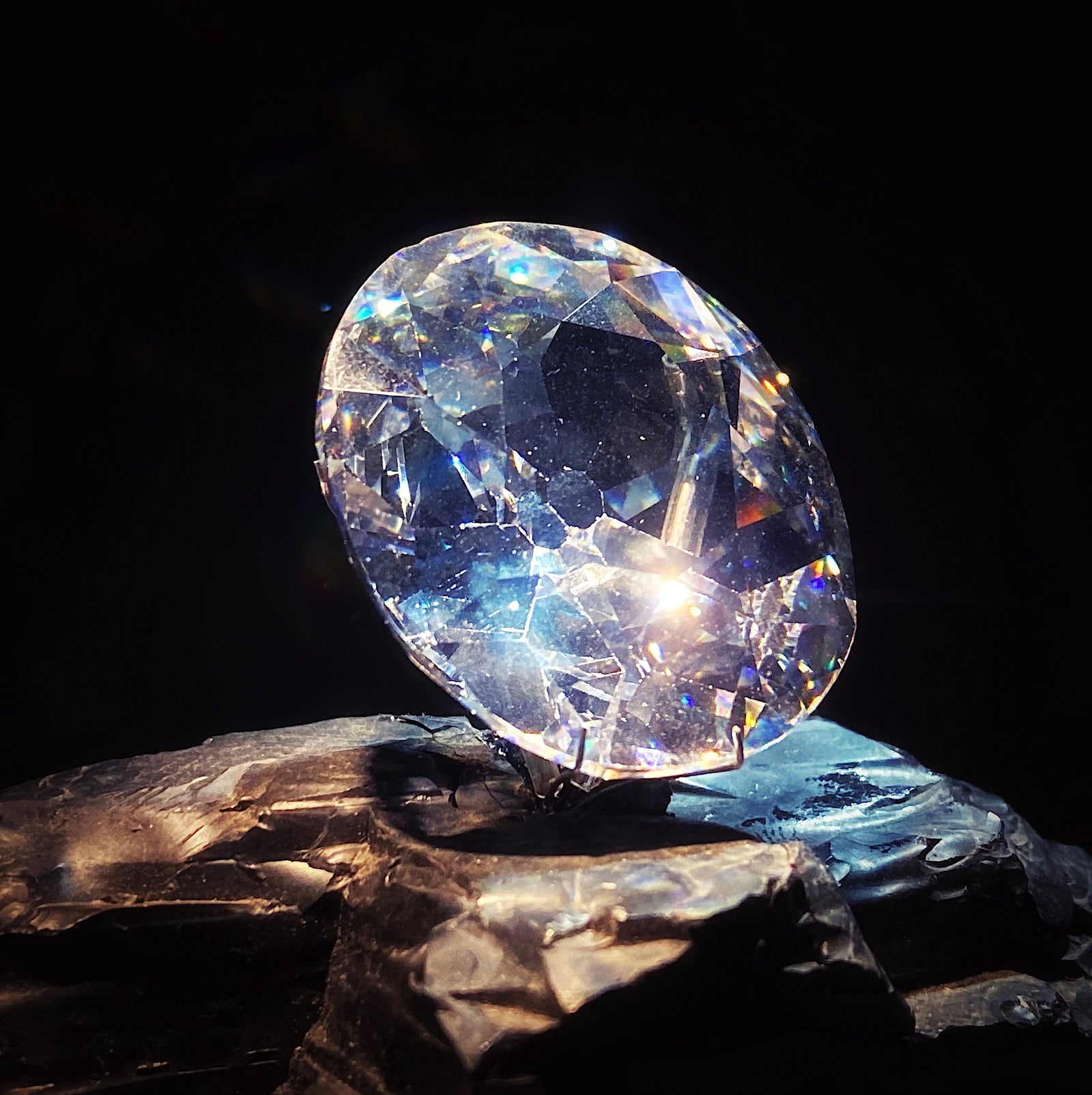As purveyors of fine antique and estate jewelry, we at Howard’s Diamond Center are fortunate to see a variety of antique cut diamonds. Two of our favorites are Old Mine Cuts and Old European Cuts. In this article, we will discuss the history, development, similarities, and differences between these two antique cuts of diamonds.
Old Mine Cut diamonds typically have 58 facets including a large flat visible culet (point at the bottom of a diamond). Frequently, they are neither round nor square, but rather squarish with rounded corners. The facets are somewhat uneven and have a wide chunky appearance that gives the diamond big flashes of fire. The girdle (edge at the widest part of the diamond) tends to be unpolished and the table (flat top of the diamond) tends to be very small. They usually have a high crown and deep pavilion (areas above and below the diamond’s girdle).
Old European Cut diamonds have many of the same characteristics of Old Mine Cut diamonds. Old European Cuts also have 58 facets including a flat visible culet. The facets can also appear chunky and somewhat uneven. The girdles are usually unpolished and they too have a high crown, deep pavilion, and smaller table size. One important difference is that Old European Cuts tended to be rounder. Seldom were they perfectly symmetrical, but they were significantly more round than the Old Mine Cuts that preceded them.
The round shape of Old European Cut diamonds was achieved with the invention in 1874 of the steam powered bruting machine which allowed for one diamond to be fixed to a spinning lathe and another to a dopstick, held against it as it revolves. Since diamond is the hardest natural substance on Earth, the only way to grind a rough diamond crystal is with another diamond. The steam powered bruting machine not only gave Master Diamond Cutters the ability to create rounder shapes, but also enabled them to create diamonds with greater scintillation (sparkle) and weight retention. The first electric bruting machine was invented in 1891.
By contrast, Old Mine Cut diamonds that were cut prior to 1874 achieved their shape from a process called rubbing. It was known since the Renaissance that rubbing one diamond against another, often by hand, could shape one or both diamonds. This technique was time consuming and required tremendous physical exertion, but it allowed rough diamonds to be shaped. However, the shapes were not optimal. It was the invention of the bruting machine that allowed for creation of symmetrical round diamonds.
In terms of age, Old Mine Cut diamonds are found predominantly in Georgian jewelry (1714-1837) and early Victorian jewelry (1819-1901). Old European Cut diamonds are usually found in later Victorian jewelry (1819-1901), Edwardian jewelry (1901-1914), and Art Deco jewelry (1915-1935).
Often, when one looks at antique Old Mine Cut diamonds and to a lesser extent Old European Cut diamonds, the diamond color tends to be a pleasing warm color (various shades of light yellow) compared to today’s whiter colors (rarer and more expensive). This difference has more to do with the mines from which the diamonds originated, than the faceting of the diamonds themselves. The mines that existed during this period produced a greater abundance of warm yellow diamonds than cool white ones. While this is true today of almost every diamond mine, the “Old Mines” yielded an even greater percentage of yellow diamonds.
As a consequence of the abundance of slightly yellow rough diamonds, Master Diamond Cutters of this period would adjust and customize their cutting of each individual diamond to compensate for the color and produce a diamond that faces up whiter. This customization of antique cuts based on color, size, and shape of the rough diamond makes the task of perfectly matching antique cut diamonds difficult, if not, impossible. Today, round brilliant cut diamonds are fashioned with such standardization and uniformity that matching diamonds is relatively easy. However, even if antique cut diamonds (Old Mine Cuts in particular) match in color, clarity, and carat weight, the diamonds can appear very different due to the customization of each diamond’s cut. And while its easy to think that the jewelry of that period suffered from not having perfectly matched diamonds, nothing could be further from the truth. The British Royal jewels are the perfect example. Whether it’s a resplendent crown, tiara, necklace, or brooch the presence of slightly mismatched antique cut diamonds in no way detracts from the grandeur and majesty of the British Royal jewels. Rather, it is the presence of these perfectly-imperfect antique cut diamonds, that creates the charm, glamour, and allure of the Royal jewels. If one thinks of it in terms of fashion, modern round brilliant cut diamonds would represent ready-to-wear fashion, while antique cut diamonds would represent high-end handmade couture fashion where the sewing is done entirely by hand and lacks the uniformity of machine sewing.
Something else that Old Mine and Old European cuts have in common is their rarity. This is due, in part, to the scarcity of diamonds during this period. The oldest diamond mines in the world were located in India. While no one knows precisely when mining started, there are records that suggest diamond mining existed in India prior to the 4th century BC. In fact, until the 1730’s, India was the world’s only source of diamonds. Unlike today’s highly mechanized and automated diamond mining operations, much of the mining that was done in India was done entirely by hand. Today, diamond bearing ore is blasted and loosened using dynamite, then loaded onto dump trucks the size of a two story house and transported to a sorting facility where the ore is crushed and placed on a conveyor belt where it is scanned with X-rays to reveal the diamonds. In ancient India, its easy to imagine ore being dug with shovels, rock hammers, and chisels, then being transported by mule or horse and searched by hand and eyesight. This labor intensive method of diamond mining resulted in low annual productivity per mine compared to today’s standards. It has been estimated that total production was around 30 million carats for the centuries of diamond mining that occurred in India. To put this in perspective, the most productive diamond mine in the world, the Argyle Mine in Australia (recently closed), produced an average of 35 million carats of diamonds per year with only 5% being gem quality and a high percentage of those having various shades of brown color. The low annual productivity of Indian mines compared to today’s mines, meant that diamonds were scarce, expensive, and largely unavailable to the masses.
Just as diamond mines in India were being exhausted in 1725 to 1730, diamonds were discovered in Brazil. The Brazilian mines produced so many diamonds that it resulted in a 30% drop in rough diamond prices. This made diamonds more affordable to more people. But the prices began to rise again in the mid 1800’s as the Brazilian supply of diamonds was beginning to be exhausted. In 1866, the Eureka diamond was discovered in South Africa and helped usher in the African diamond boom.
The scarcity of rough diamonds in the 18th and 19th centuries is part of the reason why Old Mine and Old European cut diamonds are so rare. Another reason is that for many decades, jewelers would almost instinctively have recut into modern round diamonds any Old Mine and Old European cut diamonds that they acquired. It was thought that modern cuts were more desirable and therefore easier to market. Today, there is a growing market for these uniquely cut diamonds.
Something else that Old Mine and Old European cut diamonds have in common is they both have large flat culets. The culet is the point on the underside of a faceted diamond. Today’s round brilliant cut diamonds have an underside shaped like a cone where all the facets come together at a very small and sharp point. However, in the 18th and 19th centuries the diamond cutting technology did not allow for the creation of such a small culet and any attempt to create one would have resulted in a broken or chipped diamond. Therefore, in place of a pointy culet the Master Diamond Cutters of the time would polish a flat facet parallel to the diamond’s table. Because this culet facet was parallel to the diamond’s table it was a source of light leakage within the diamond, something diamond cutters try to avoid as it can reduce the diamond’s sparkle. But when the same diamond is tilted, the flat culet facet then becomes an ordinary facet that acts as a window allowing light to enter the diamond and be reflected towards the wearer.
The presence of a large flat culet facet in Old Mine and Old European cut diamonds give rise to another shared property called the Kozibe Optical Effect. It’s a little known property of Old Mine and Old European cut diamonds that has little impact on the value of the stone, but is especially interesting to me (and diamond nerds like me) because I’ve seen the Kozibe Optical Effect countless times but did not realize there was a name for it. Simply put, the Kozibe Effect is the ability to see numerous optical reflections of the flat culet facet across the crown (upper part) of a diamond. The term “Kozibe” was introduced by Antwerp’s Diamond High Council and is an abbreviation for “kottet zichtbaar in bezelen” which translates to “culet visible in bezel/crown.” The effect is most commonly seen in antique cut diamonds that have a thicker chunkier cut and a flat culet facet. And while it has little to no impact on the value of a diamond, some people appreciate the optical effect and others do not (count me among the Kozibe afficionados!).
And finally, let’s discuss the overall appearance of Old Mine and Old European cut diamonds. There are many who will say that these rare artisanal couture cut diamonds lack the fire and brilliance of modern brilliant cut diamonds. And while that may be true under some lighting conditions, its important to understand that antique cut diamonds were not designed to be seen under harsh fluorescent or incandescent lights. These diamonds were faceted in daylight or, more often than not, by gas light or candle light. If you are fortunate enough to own one of these scarce and timeless treasures, wear it during a romantic candle lit dinner and you will witness the diamond coming to life in a way that modern cut diamonds cannot. The mesmerizing glow of an antique cut diamond under candle light is an eternal testament to the artistry and experience of its long departed Master Diamond Cutter. They are meant to be cherished and not just observed. Old Mine and Old European cut diamonds are more than unique and exquisitely faceted diamonds, they are a connection to the past, to our past.
The Antique and Estate Jewelry Department at Howard’s Diamond Center is pleased to present a wide selection of Old Mine and Old European cut diamonds in sizes up to 4 carats.





















